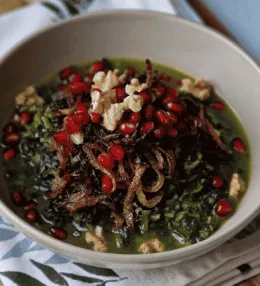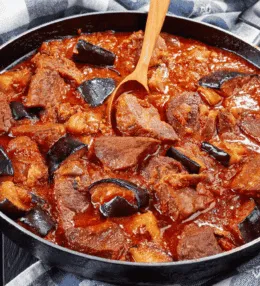
- View
Table of Contents
ToggleSekuwa is one of Nepal’s most treasured grilled meat dishes, known for its smoky aroma, bold spices and street side charm. It is more than just skewered meat on firewood or charcoal; it reflects the rustic soul of Nepalese cooking, where open flames and hand ground spices come together with pride and tradition.
Often enjoyed as a snack with a glass of local alcohol or served during festive gatherings, sekuwa is a dish that brings people together. Whether it is sold at roadside stalls or cooked over open fires in village homes, it holds a timeless appeal across regions and communities.
Want to dive deeper into Nepalese Cuisine? Don’t miss our post on 15 Traditional Nepalese Foods to Try
What Is Sekuwa?
Sekuwa is essentially marinated meat grilled over a wood fire, but its flavour and cultural relevance stretch far beyond that simple description. The meat is usually skewered before cooking, allowing it to char slightly while absorbing the fragrance of wood smoke and the complexity of Nepalese spices.
Traditionally, sekuwa is made using pork, chicken, goat or buffalo. Each version has its own following, with locals often loyal to a particular type. Though the recipe is easily adaptable, what remains constant is the method of grilling over fire, often without modern grills or gas.
Ingredients and Taste
The marinade is where sekuwa’s flavour is born. It usually includes garlic, ginger, cumin, coriander, turmeric, chilli, mustard oil and salt. Some recipes call for fenugreek, lemon juice or yoghurt to tenderise the meat and deepen the taste. The mix is left to soak into the meat for hours.
Once grilled, the outside develops a slightly crisp, charred coating while the inside remains tender and juicy. The first bite offers a rush of spice and smoke, followed by warm, earthy undertones that linger on the tongue. It is fiery, but not overwhelming, with a balance that keeps you reaching for more.
A Taste of History
Sekuwa’s roots are deeply tied to Nepal’s rural traditions, where grilling meat over open flames has been common for centuries. It gained popularity as a celebratory food, shared during harvests, weddings and gatherings. Its simplicity made it accessible, while its flavour made it unforgettable.
Though often associated with the eastern hills of Nepal, especially the regions around Dharan and Sunsari, sekuwa is now beloved across the country. Vendors line the streets of cities like Kathmandu, each offering their own twist, keeping the spirit of the dish alive in every smoky skewer.
From village feasts to city street stalls, sekuwa continues to evolve while staying true to its roots. It is a dish that tells stories of land, labour and laughter. Every bite holds the essence of Nepal’s rugged terrain, resourceful cooking and the warmth of shared meals.
Whether you try it fresh off the skewer from a roadside grill or recreate it at home, sekuwa invites you into a flavourful corner of Nepalese life. It is not just food on a stick; it is fire kissed tradition, seasoned with pride and offered with open hands.
How to Make Nepali Sekuwa
Sekuwa is a beloved street food in Nepal, known for its smoky char, bold spices and tender meat. Traditionally cooked over a wood fire, it captures the spirit of open flame grilling with layers of earthy and aromatic flavours. Expect a simple but rewarding process of marinating and grilling, where every step enhances the rich taste of the final dish. Quick tip before you begin, allow plenty of marination time for deeper flavour. See the recipe card at the bottom for printable directions
Ingredients
- 600g boneless pork, lamb or chicken (cut into bite sized chunks)
- 3 tbsp plain yoghurt
- 1 tbsp mustard oil (or vegetable oil)
- 1 tbsp garlic paste
- 1 tbsp ginger paste
- 1 tsp ground cumin
- 1 tsp coriander powder
- 1 tsp turmeric powder
- 1 tsp chilli powder (adjust to taste)
- 1 tsp garam masala
- ½ tsp fenugreek seeds (optional, for extra depth)
- 1 tsp salt
- Juice of 1 medium lemon
- 1 tbsp finely chopped fresh coriander
- Bamboo or metal skewers (if bamboo, soak in water for 30 minutes)
Cooking Instructions
Step 1: Prepare the Marinade
In a large mixing bowl, combine yoghurt, mustard oil, garlic paste, ginger paste, cumin, coriander, turmeric, chilli powder, garam masala and salt. Stir until smooth and well blended. For a traditional touch, lightly toast fenugreek seeds and crush them before adding.
Step 2: Marinate the Meat
Add the meat pieces to the marinade and mix thoroughly using your hands to ensure every piece is evenly coated. Cover the bowl and refrigerate for at least 4 hours or overnight for best flavour development.
Step 3: Preheat the Grill or Oven
Preheat a grill to medium to high or set your oven to 220°C. If using an oven, place a rack over a baking tray to allow air circulation around the meat.
Step 4: Skewer the Meat
Thread the marinated meat onto skewers, leaving a small gap between each piece to help them cook evenly. Avoid packing them too tightly to maintain airflow during grilling.
Step 5: Grill the Sekuwa
Place the skewers on the grill or oven rack. Cook for 15 to 18 minutes, turning occasionally to ensure a nice char on all sides. Baste with a bit of oil or leftover marinade halfway through to keep the meat juicy.
Step 6: Check for Doneness
Ensure the meat is cooked through and has a slight char. Chicken should be white and firm inside, pork or lamb should be tender with no raw centre. A meat thermometer should read at least 75°C for chicken.
Step 7: Rest the Meat
Once cooked, let the skewers rest for 5 minutes. This helps the juices settle and keeps the meat moist when served.
Step 8: Prepare for Serving
Sprinkle chopped fresh coriander over the meat. Squeeze some fresh lemon juice if desired. You can also lightly brush the skewers with melted butter for added richness.
Step 9: Garnish and Plate
Arrange the skewers on a platter. Serve with sliced onions, fresh cucumber and tomato salad, or Nepali achar (pickle) for a full experience.
Final Step: Serve and Enjoy
Serve hot as a main course or appetiser. Traditionally, Sekuwa pairs beautifully with beaten rice (chiura) or flatbreads. Offer a side of tangy yoghurt dip or mint chutney to elevate the dish’s vibrant flavours.
Cooking Tips for Perfect Sekuwa
- Toasting fenugreek seeds adds a smoky bitterness that enhances authenticity
- Use mustard oil if available for its distinct aroma and traditional flavour
- Don’t skip the resting time after grilling, as it keeps the meat tender
- Charcoal grilling gives the best flavour but oven grilling works well too
- For extra juiciness, marinate overnight and bring the meat to room temperature before cooking

Nepali Sekuwa (Skewered Grilled Meat)
Ingredients
- 600 g boneless chicken pork or lamb (cut into bite sized chunks)
- 3 tbsp plain yoghurt
- 1 tbsp mustard oil or vegetable oil
- 1 tbsp garlic paste
- 1 tbsp ginger paste
- 1 tsp ground cumin
- 1 tsp coriander powder
- 1 tsp turmeric powder
- 1 tsp chilli powder adjust to taste
- 1 tsp garam masala
- ½ tsp fenugreek seeds optional, for extra depth
- 1 tsp salt
- Juice of 1 medium lemon
- 1 tbsp finely chopped fresh coriander
- Bamboo or metal skewers if bamboo, soak in water for 30 minutes
Instructions
- In a large mixing bowl, combine yoghurt, mustard oil, garlic paste, ginger paste, cumin, coriander, turmeric, chilli powder, garam masala and salt. Stir until smooth and well blended. For a traditional touch, lightly toast fenugreek seeds and crush them before adding.
- Add the meat pieces to the marinade and mix thoroughly using your hands to ensure every piece is evenly coated. Cover the bowl and refrigerate for at least 4 hours or overnight for best flavour development.
- Preheat a grill to medium to high or set your oven to 220°C. If using an oven, place a rack over a baking tray to allow air circulation around the meat.
- Thread the marinated meat onto skewers, leaving a small gap between each piece to help them cook evenly. Avoid packing them too tightly to maintain airflow during grilling.
- Place the skewers on the grill or oven rack. Cook for 15 to 18 minutes, turning occasionally to ensure a nice char on all sides. Baste with a bit of oil or leftover marinade halfway through to keep the meat juicy.
- Ensure the meat is cooked through and has a slight char. Chicken should be white and firm inside, pork or lamb should be tender with no raw centre. A meat thermometer should read at least 75°C for chicken.
- Once cooked, let the skewers rest for 5 minutes. This helps the juices settle and keeps the meat moist when served.
- Sprinkle chopped fresh coriander over the meat. Squeeze some fresh lemon juice if desired. You can also lightly brush the skewers with melted butter for added richness.
- Arrange the skewers on a platter. Serve with sliced onions, fresh cucumber and tomato salad, or Nepali achar (pickle) for a full experience.
- Serve hot as a main course or appetiser. Traditionally, Sekuwa pairs beautifully with beaten rice (chiura) or flatbreads. Offer a side of tangy yoghurt dip or mint chutney to elevate the dish’s vibrant flavours.
Nutrition
You May Also Like







Leave a Review